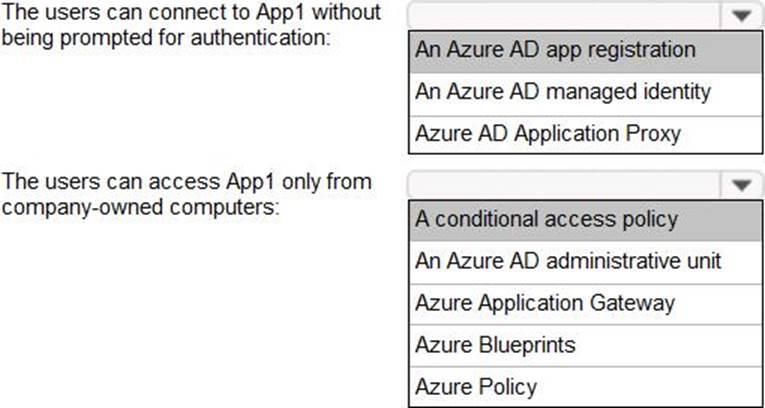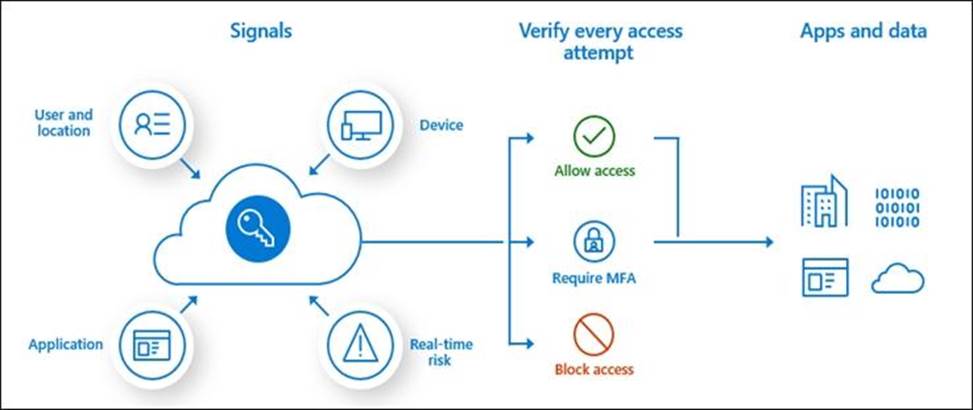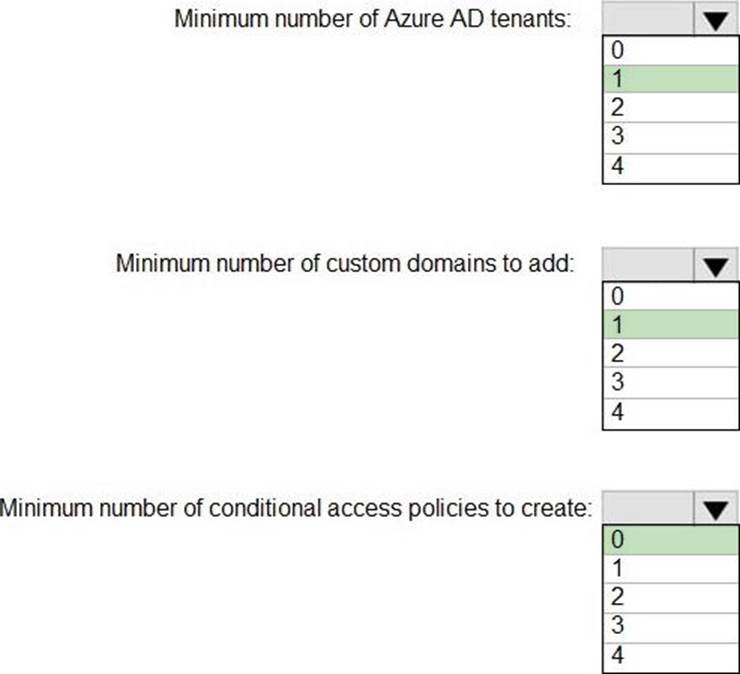Microsoft AZ-305 Real Exam Questions
The questions for AZ-305 were last updated at Jul 06,2025.
- Exam Code: AZ-305
- Exam Name: Designing Microsoft Azure Infrastructure Solutions
- Certification Provider: Microsoft
- Latest update: Jul 06,2025
Note: This question is part of a series of questions that present the same scenario. Each question in the series contains a unique solution that might meet the stated goals. Some question sets might have more than one correct solution, while others might not have a correct solution.
After you answer a question in this section, you will NOT be able to return to it. As a result, these questions will not appear in the review screen.
Your company has deployed several virtual machines (VMs) on-premises and to Azure. Azure ExpressRoute has been deployed and configured for on-premises to Azure connectivity.
Several VMs are exhibiting network connectivity issues.
You need to analyze the network traffic to determine whether packets are being allowed or denied to the VMs.
Solution: Use the Azure Traffic Analytics solution in Azure Log Analytics to analyze the network traffic.
Does the solution meet the goal?
- A . Yes
- B . No
You need to recommend a solution to meet the database retention requirement.
What should you recommend?
- A . Configure a long-term retention policy for the database.
- B . Configure Azure Site Recovery.
- C . Configure geo replication of the database.
- D . Use automatic Azure SQL Database backups.
HOTSPOT
You plan to deploy an Azure web app named Appl that will use Azure Active Directory (Azure AD) authentication.
App1 will be accessed from the internet by the users at your company. All the users have computers that run Windows 10 and are joined to Azure AD.
You need to recommend a solution to ensure that the users can connect to App1 without being prompted for authentication and can access App1 only from company-owned computers.
What should you recommend for each requirement? To answer, select the appropriate options in the answer area. NOTE: Each correct selection is worth one point.
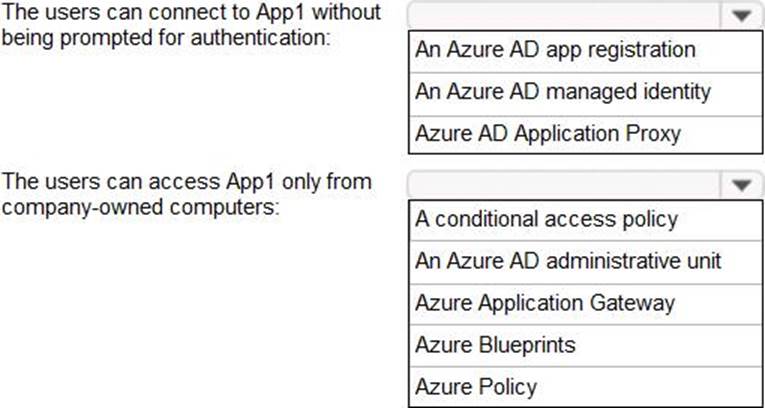
Your company has 300 virtual machines hosted in a VMware environment. The virtual machines vary in size and have various utilization levels.
You plan to move all the virtual machines to Azure.
You need to recommend how many and what size Azure virtual machines will be required to move the current workloads to Azure. The solution must minimize administrative effort.
What should you use to make the recommendation?
- A . Azure Cost Management
- B . Azure Pricing calculator
- C . Azure Migrate
- D . Azure Advisor
HOTSPOT
You have an on-premises file server that stores 2 TB of data files.
You plan to move the data files to Azure Blob Storage In the West Europe Azure region,
You need to recommend a storage account type to store the data files and a replication solution for the storage account.
The solution must meet the following requirements:
• Be available if a single Azure datacenter fails.
• Support storage tiers.
• Minimize cost.
What should you recommend? To answer, select the appropriate options in the answer area. NOTE: Each correct selection is worth one point.

You have SQL Server on an Azure virtual machine. The databases are written to nightly as part of a batch process.
You need to recommend a disaster recovery solution for the data.
The solution must meet the following requirements:
✑ Provide the ability to recover in the event of a regional outage.
✑ Support a recovery time objective (RTO) of 15 minutes.
✑ Support a recovery point objective (RPO) of 24 hours.
✑ Support automated recovery.
✑ Minimize costs.
What should you include in the recommendation?
- A . Azure virtual machine availability sets
- B . Azure Disk Backup
- C . an Always On availability group
- D . Azure Site Recovery
You plan to deploy 10 applications to Azure. The applications will be deployed to two Azure Kubernetes Service (AKS) clusters. Each cluster will be deployed to a separate Azure region.
The application deployment must meet the following requirements:
• Ensure that the applications remain available if a single AKS cluster fails.
• Ensure that the connection traffic over the internet is encrypted by using SSL without having to configure SSL on each container.
Which service should you include in the recommendation?
- A . AKS ingress controller
- B . Azure Traffic Manager
- C . Azure Front Door
- D . Azure Load Balancer
Topic 2, Fabrikam, inc Case Study A
Overview:
Existing Environment
Fabrikam, Inc. is an engineering company that has offices throughout Europe. The company has a main office in London and three branch offices in Amsterdam Berlin, and Rome.
Active Directory Environment:
The network contains two Active Directory forests named corp.fabnkam.com and rd.fabrikam.com. There are no trust relationships between the forests. Corp.fabrikam.com is a production forest that contains identities used for internal user and computer authentication. Rd.fabrikam.com is used by the research and development (R&D) department only. The R&D department is restricted to using on-premises resources only.
Network Infrastructure:
Each office contains at least one domain controller from the corp.fabrikam.com domain.
The main office contains all the domain controllers for the rd.fabrikam.com forest.
All the offices have a high-speed connection to the Internet.
An existing application named WebApp1 is hosted in the data center of the London office. WebApp1 is used by customers to place and track orders. WebApp1 has a web tier that uses Microsoft Internet Information Services (IIS) and a database tier that runs Microsoft SQL Server 2016. The web tier and the database tier are deployed to virtual machines that run on Hyper-V.
The IT department currently uses a separate Hyper-V environment to test updates to WebApp1.
Fabrikam purchases all Microsoft licenses through a Microsoft Enterprise Agreement that includes Software Assurance.
Problem Statement:
The use of Web App1 is unpredictable. At peak times, users often report delays. At other times, many resources for WebApp1 are underutilized.
Requirements:
Planned Changes:
Fabrikam plans to move most of its production workloads to Azure during the next few years.
As one of its first projects, the company plans to establish a hybrid identity model, facilitating an upcoming Microsoft Office 365 deployment All R&D operations will remain on-premises.
Fabrikam plans to migrate the production and test instances of WebApp1 to Azure.
Technical Requirements:
Fabrikam identifies the following technical requirements:
• Web site content must be easily updated from a single point.
• User input must be minimized when provisioning new app instances.
• Whenever possible, existing on premises licenses must be used to reduce cost.
• Users must always authenticate by using their corp.fabrikam.com UPN identity.
• Any new deployments to Azure must be redundant in case an Azure region fails.
• Whenever possible, solutions must be deployed to Azure by using platform as a service (PaaS).
• An email distribution group named IT Support must be notified of any issues relating to the directory synchronization services.
• Directory synchronization between Azure Active Directory (Azure AD) and corp.fabhkam.com must not be affected by a link failure between Azure and the on premises network.
Database Requirements:
Fabrikam identifies the following database requirements:
• Database metrics for the production instance of WebApp1 must be available for analysis so that database administrators can optimize the performance settings.
• To avoid disrupting customer access, database downtime must be minimized when databases are migrated.
• Database backups must be retained for a minimum of seven years to meet compliance requirement
Security Requirements:
Fabrikam identifies the following security requirements:
* Company information including policies, templates, and data must be inaccessible to anyone outside the company
* Users on the on-premises network must be able to authenticate to corp.fabrikam.com if an Internet link fails.
* Administrators must be able authenticate to the Azure portal by using their corp.fabrikam.com credentials.
* All administrative access to the Azure portal must be secured by using multi-factor authentication.
* The testing of WebApp1 updates must not be visible to anyone outside the company.
HOTSPOT
To meet the authentication requirements of Fabrikam, what should you include in the solution? To answer, select the appropriate options in the answer area. NOTE: Each correct selection is worth one point.
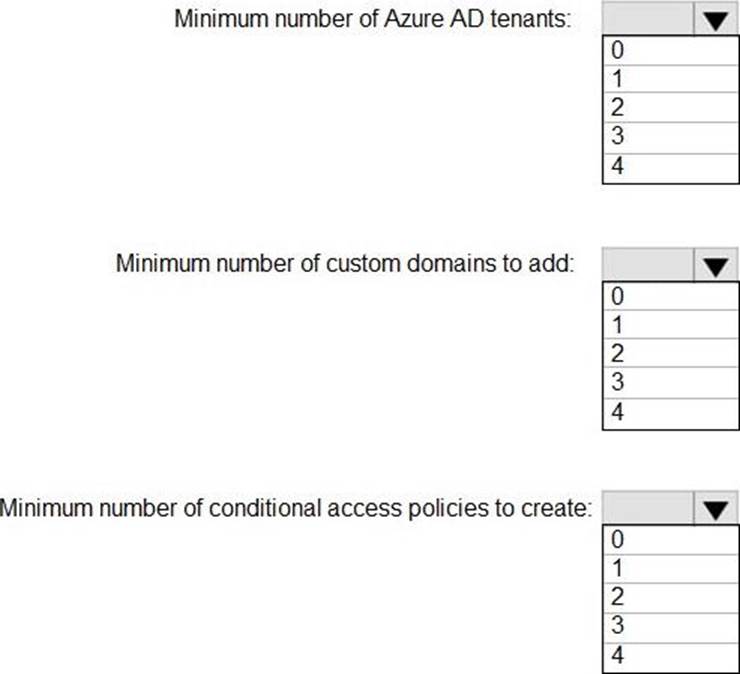
Your company has the infrastructure shown in the following table.

The on-premises Active Directory domain syncs to Azure Active Directory (Azure AD).
Server1 runs an application named Appl that uses LDAP queries to verify user identities in the on-premises Active Directory domain.
You plan to migrate Server1 to a virtual machine in Subscription1.
A company security policy states that the virtual machines and services deployed to Subscription1 must be prevented from accessing the on-premises network.
You need to recommend a solution to ensure that Appl continues to function after the migration. The solution must meet the security policy.
What should you include in the recommendation?
- A . Azure AD Domain Services (Azure AD DS)
- B . an Azure VPN gateway
- C . the Active Directory Domain Services role on a virtual machine
- D . Azure AD Application Proxy
You ate designing a SQL database solution. The solution will include 20 databases that will be 20 GB each and have varying usage patterns. You need to recommend a database platform to host the databases.
The solution must meet the following requirements:
• The compute resources allocated to the databases must scale dynamically.
• The solution must meet an SLA of 99.99% uptime.
• The solution must have reserved capacity.
• Compute charges must be minimized.
What should you include in the recommendation?
- A . 20 databases on a Microsoft SQL server that runs on an Azure virtual machine
- B . 20 instances of Azure SQL Database serverless
- C . 20 databases on a Microsoft SQL server that runs on an Azure virtual machine in an availability set
- D . an elastic pool that contains 20 Azure SQL databases

